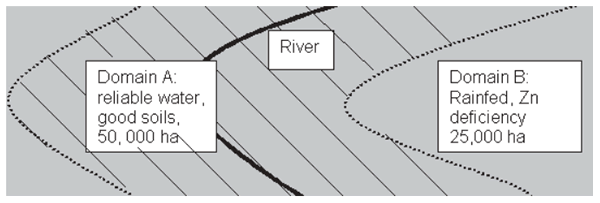Domains for testing or upscaling technology options
What is a domain?
A domain is an area where a single recommendation has broad application due to similarities in both socio-economic and environmental conditions.
Why is it important to identify domains?
To make sure recommendations are suitable for in terms of environmental and socio-economic conditions.
How are domains defined?
- Participatory field appraisal using secondary data and maps
- Involve farmer leaders; extension workers, researchers; and government administrators
- Divide the region into domains taking into account the major factors that affect farming such as:
Characteristic |
Example/why important |
| Availability to water | Irrigated vs Rainfed - Access to reliable water supply |
| Soil type or soil problems | Fertile areas vs areas with problems (e.g., Fe Toxicity, ZN deficiency) |
| Topography/slope position | Hillsides, Valley bottoms, Waterlogged areas |
| Income groups | Resources limitations may limit adoption |
| Labor availability | Labor shortages during critical periods (e.g., crop establishment, weeding or harvest) may limit options? |
| Farm size | e.g., Small < 0.25 ha vs large > 10 ha affects options |
| Cropping system | Rice-rice versus Rice-wheat: Crop effects on subsequent crop (e.g., planting date, soil condition) |
| Other known problems | Problems such as Tungro or rodents may affect only some areas |
| Access to inputs and markets | Inputs not available, or market surplus sold on a depressed market - reducing profit |
Outcome
Maps (see example), reports, and decisions on where selected technologies will be tested (may not be in each domain).

Prepared with input from: MA Bell, JF Rickman, V Balasubramanian, and M Escalada







